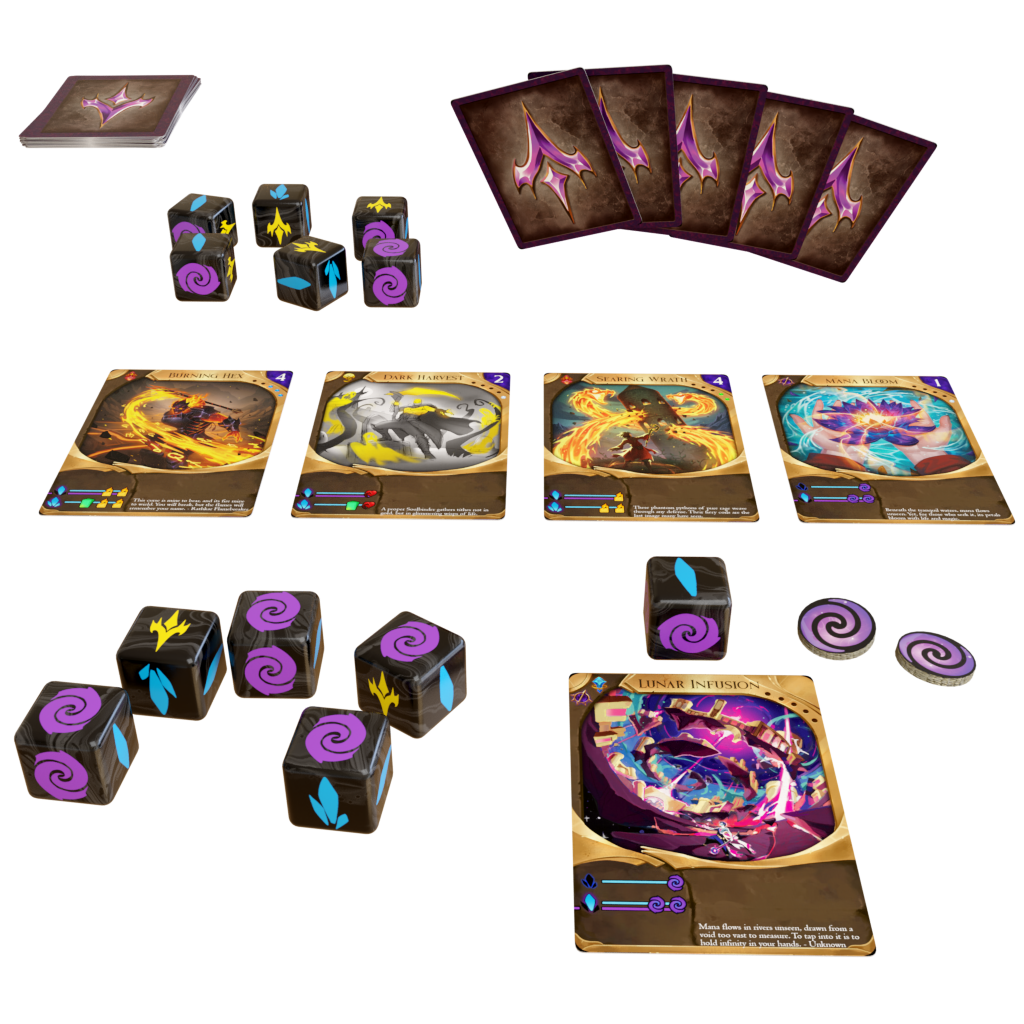Instant Impact: Mastering the Trigger Mechanic in Riftblade
"Why would I Trigger a spell, getting its benefit only once, when I could add it to my deck for the same price?" It's one of the most common questions newer Riftblade players ask. The allure of permanently adding a powerful card to your deck is strong. But Triggering – playing a card directly from The Rift for a one-time effect – is a crucial tactical tool that can often mean the difference between victory and defeat. Let's break down when immediate impact trumps future potential.
Scenario: The Mid-Game Turning Point
Imagine this board state where you have an opponent playing a Soul/Void based deck against your Infernal/Celestial setup. The game has hit full steam and you’re both sitting around 15 life. Now, it’s your turn and you’re sitting on seven mana and a very compelling set of choices in The Rift. What do you do?
From Left to Right In the Rift: Burning Hex (Rare, 4), Dark Harvest (Common, 2), Searing Wrath (Uncommon, 4), Mana Bloom (Common, 1)
The obvious temptation — Grab Burning Hex. It's a potent Infernal card, a perfect fit for your Infernal/Celestial build. Why wouldn't you add it to your deck? Let's dig deeper and analyze the critical factors:
1) Deck Size & Turns Remaining
You have about 8 cards left in your deck and a similar amount in your discard pile. Without significant card draw (which your Infernal/Celestial build likely lacks compared to Chaos), cycling your deck takes time. Realistically, you'll need at least three turns, maybe up to six, before you draw and can play that Burning Hex you just bought.
2) Life Totals, Racing Against Time
You're slightly behind at 12 life to your opponent's 15, and the game has reached a stage where both players are likely dealing 5+ damage per turn (even with some healing). Best case? Maybe 3-5 turns left. Worst case? The game could be over in two turns. Will that Burning Hex even see play before someone hits zero?
3) Opponent Potential and Disrupting Their Next Turn
Your opponent has a hand of five cards and made a powerful Riftstone roll, so they're poised to unleash significant damage. Buying Burning Hex does nothing to stop that, but what if you could force them down to two cards before they had a chance to cast a spell?
Putting it Together: Why Triggering Wins Here
Consider the facts:
You likely only have ~4 turns left maximum.
A purchased Burning Hex will take at least 3 turns to even appear in your hand, let alone be played. You'll almost certainly never play it twice.
You need a Riftstone to play it when you draw it.
Your opponent is ready to hit you hard next turn.
The conclusion is becoming clear: The immediate impact of Triggering outweighs the diminishing potential of buying. Hitting your opponent now is better than hoping you can hit them turns later, assuming you're still in the game.
Furthermore, think about the discard effect of Burning Hex. If you wait several turns to play it, your opponent might have a larger hand to resist the burn, or perhaps a mana-heavy Riftstone roll, making the discard nearly worthless. Triggering it now maximizes its disruptive value.
The Play: Forget buying. Trigger Mana Bloom first. (Yes, its Trigger gains you 1 mana!) This pushes you to 8 mana. Now, Trigger both Burning Hex (4 mana) and Searing Wrath (4 mana). This delivers a significant blow: three direct damage plus forcing your opponent to discard three cards before their turn, potentially crippling their planned assault.
Beyond the Big Hit: More Trigger Opportunities
That 3-Burn combo from The Rift might seem rare, but Triggering offers tactical advantages in many situations. Look for opportunities to convert mana directly into value when buying doesn't make sense.
Example: Turning Scraps into Damage & Healing
From Left to Right: Starstrike (Common, 3), Oblivion (Uncommon, 3), Wild Surge (Common, 2), Dark Harvest (Common, 2)
This Rift looks underwhelming. But what if you have 7 mana? Trigger Oblivion dealing 1 damage and gaining 1 mana. Now at 7 mana again, Trigger Dark Harvest (2 mana) for 1 damage and 1 life gain, Wild Surge (2 mana) for 1 damage, and Star Strike (3 mana) for 1 damage and another life. Total Effect: 4 damage dealt, 2 life gained; a significant swing ready to be compounded by your own spellcasting.
Example: The Trigger-Refresh Gambit
From Left to Right: Soul Scorch (Common, 5), Rift Burn (Common, 3), Mana Bloom (Common, 1), and Radiant Gale (Common, 2)
This layout is a trap. You could Trigger Fate’s Twist and buy Soul Scorch—most players would, and this might be fine in the early game. But what if you ignore Soul Scorch and instead Triggered both Fate’s Twist and Radiant Gale before spending a Mana Riftstone to refresh the board? You’d be left with three mana to play with and there a ton of great three mana options for purchase or Triggering that you could unveil (Spirit Pull, Divine Light, or Starstrike, just to name a few). It's a calculated risk, but it prioritizes immediate board impact and potential upside over waiting for Soul Scorch to eventually make its way into your hand.
The Final Tempering: Seize the Moment
Buying cards builds your engine for the long haul. But Riftblade is often decided by tempo and seizing opportunities. Especially in the mid-to-late game, ask yourself:
Will I realistically draw and play this card multiple times before the game ends?
Is the immediate damage, disruption, or utility from Triggering more valuable right now than adding this card to my deck?
Can Triggering prevent my opponent from capitalizing on their best play during the next turn?
Often, the answer lies in Triggering. Don't just build for a future that might not arrive – use the Rift to win the turn, and potentially, the game. Happy dueling, Riftblades!



